The sizzling sound of yakisoba in a hot pan is like music to my ears, instantly transporting me to bustling Japanese street markets. This Quick and Flavorful Japanese Yakisoba with Cabbage & Carrots is your ticket to an easy, delicious dinner that comes together in under 20 minutes. Perfect for busy weeknights, this stir-fry not only highlights vibrant vegetables but also offers flexibility with ingredient swaps, making it delightful for vegetarians and meat lovers alike. Packed with savory, slightly sweet notes, it’s a dish I find myself turning to again and again when I need a comforting meal that doesn’t skimp on flavor. So, why not join me in whipping up this easy and delightful recipe that’s sure to impress everyone at your table? What variations will you try?
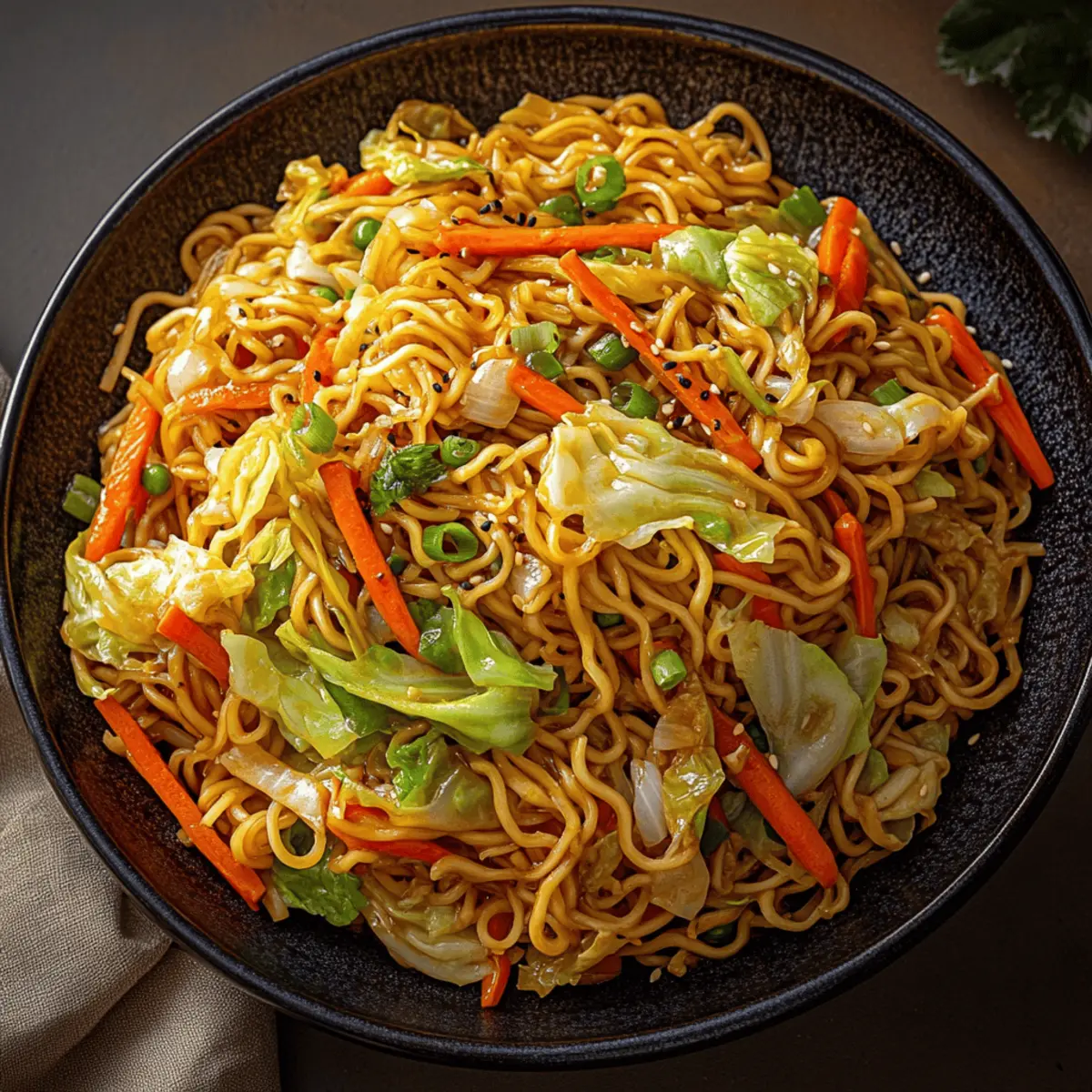
Why is Yakisoba a Weeknight Favorite?
Quick Preparation: In just 20 minutes, you can serve a delicious meal that's perfect for busy evenings.
Flavor Explosion: A delightful mix of savory and slightly sweet flavors from the sauce elevates simple ingredients.
Versatile Ingredients: Customize your yakisoba by adding your favorite veggies or proteins—tofu, chicken, or even shrimp, the choice is yours!
Healthy & Fresh: With vibrant cabbage and carrots, this dish is not just tasty but also packed with nutrients.
Boredom Buster: Say goodbye to fast food! This easy recipe is a fun way to bring Japanese street food to your kitchen. Dive into this comforting dish, and if you're seeking more delicious stir-fry options, check out my Fried Shrimp Cabbage or Sweet Potatoes Black. Enjoy!
Japanese Yakisoba with Cabbage & Carrots Ingredients
For the Stir-Fry
• Vegetable Oil – Adds fat for cooking and prevents ingredients from sticking. Substitution: Canola or avocado oil may also be used.
• Yakisoba Noodles – The base of the dish; fresh or instant-style noodles provide a quick cook time. Note: Soak in warm water to loosen if using instant noodles.
• Onion – Adds sweetness and depth of flavor. Preparation: Thinly sliced.
• Carrots – Provides sweetness and texture. Preparation: Julienned to ensure quick cooking.
• Green Cabbage – Contributes bulk and crunch. Preparation: Shredded.
• Green Onions – Offers fresh flavor; used twice in cooking and as garnish. Preparation: Sliced, with white/light green parts for cooking and dark green for garnish.
For the Sauce
• Worcestershire Sauce – Introduces a complex umami flavor. Note: Essential for authenticity; cannot be fully substituted.
• Soy Sauce – Adds saltiness and depth. Suggestion: Use low-sodium for a lighter dish.
• Ketchup – Provides sweetness and balances flavors. Can be adjusted to taste.
• Oyster Sauce – Adds a savory note; optional for vegetarian diets. Note: Vegetarian versions are available.
• Sugar – Balances the savory flavors of the sauce.
Step‑by‑Step Instructions for Japanese Yakisoba with Cabbage & Carrots
Step 1: Prepare the Sauce
In a bowl, whisk together the Worcestershire sauce, soy sauce, ketchup, oyster sauce, and sugar until well combined. This savory mixture is essential for flavoring your Japanese yakisoba. Set the sauce aside, allowing the ingredients to meld while you move on to the noodles and veggies.
Step 2: Soak the Noodles
If you're using instant yakisoba noodles, soak them in warm water for 1–2 minutes until they loosen. Drain well and toss them with a bit of oil to prevent sticking. If you're using fresh noodles, rinse briefly under hot water. This step ensures the noodles cook perfectly in your flavorful stir-fry.
Step 3: Heat the Skillet
Place a large skillet or wok over medium-high heat and wait for faint smoke to rise. It's crucial to preheat the pan adequately to achieve that satisfying sizzle once you add the ingredients. This will keep your vegetables crisp and prevent the noodles from steaming instead of stir-frying.
Step 4: Stir-Fry the Vegetables
Add vegetable oil to the hot skillet, followed by the sliced onions and julienned carrots. Stir-fry for 2–3 minutes until the onions become translucent and the carrots soften slightly. Keep them moving with a spatula or tongs to ensure even cooking and enhance their sweetness before introducing the cabbage.
Step 5: Add Cabbage
Next, add the shredded green cabbage to the skillet. Continue to stir-fry for another 2–3 minutes until the cabbage wilts and becomes tender yet retains a bit of crunch. This vibrant addition provides bulk and texture, balancing the dish beautifully with the other vegetables.
Step 6: Incorporate the Noodles and Sauce
Gently toss the cooked yakisoba noodles into the skillet, then pour the prepared sauce evenly over the mixture. Using tongs or a spatula, ensure everything is coated well. Stir-fry for about 2–4 minutes, allowing the sauce to thicken and envelop the noodles as they get deliciously caramelized.
Step 7: Add Green Onions
Stir in most of the sliced green onions, reserving a handful for garnishing later. This final touch adds freshness and color to your Japanese yakisoba. Keep stirring until everything is mixed thoroughly, ensuring those beautiful flavors meld into each bite.
Step 8: Serve and Garnish
Once everything is hot and beautifully cooked, transfer the yakisoba to serving bowls. Garnish with the reserved green onions and, if desired, a sprinkle of sesame seeds, pickled ginger, or Kewpie mayonnaise for added flavor. Serve immediately while hot, and savor the warmth and tastes of your homemade Japanese yakisoba!
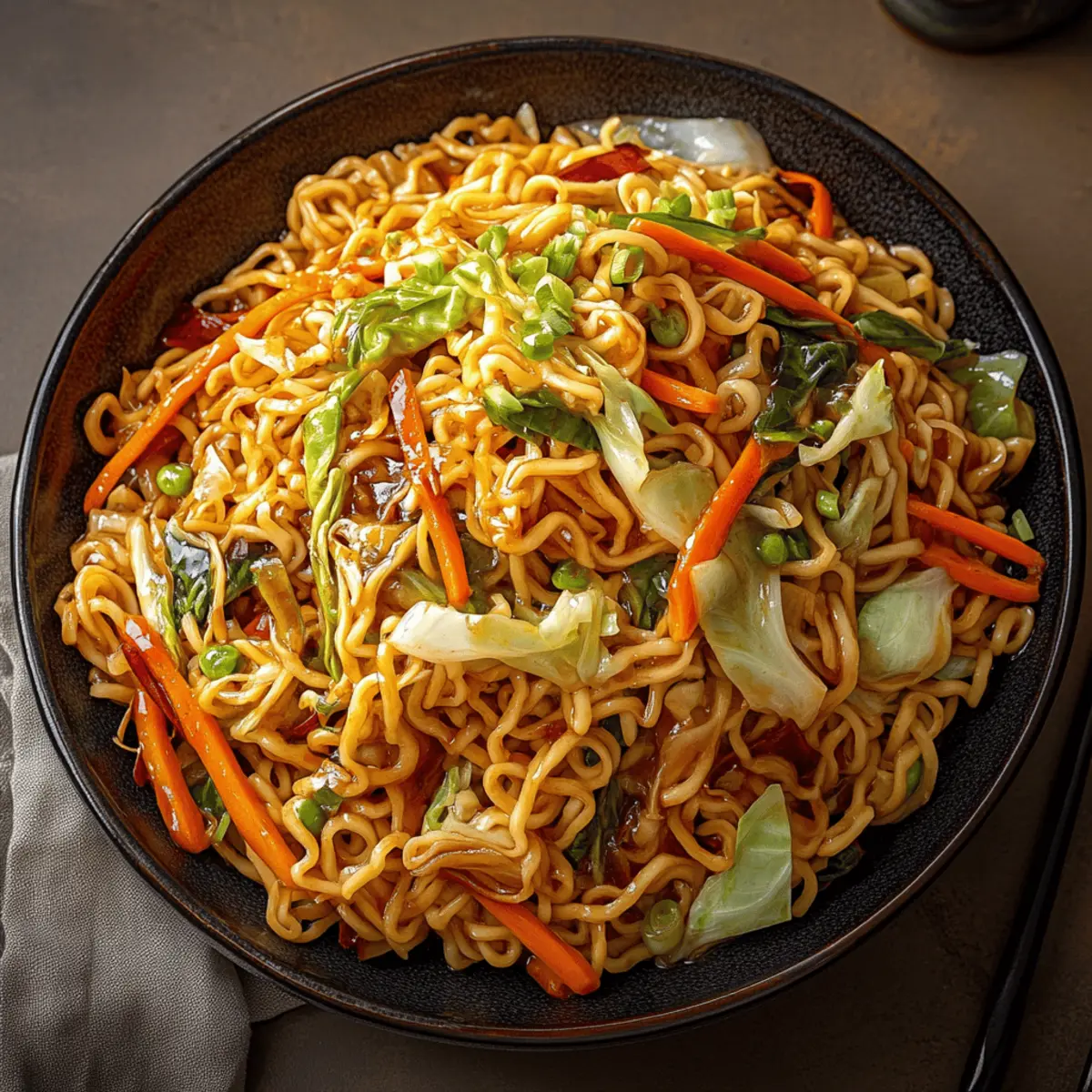
Japanese Yakisoba with Cabbage & Carrots Variations
Feel free to make this recipe your own by experimenting with different ingredients and flavors!
- Vegetable Medley: Add bell peppers, zucchini, or snow peas for a colorful crunch. Mixing in different vegetables not only enhances the flavor but adds vibrant textures to your dish.
- Protein-Packed: Toss in tofu, chicken, or shrimp to make it heartier. Simply cube the tofu or chicken, or use precooked shrimp, and stir-fry until cooked through for a satisfying meal.
- Spicy Kick: Add chili paste or sriracha to the sauce for a fiery twist. Just a dash can lift the flavors and tickle your taste buds, making each bite more exciting!
- Nutty Flavors: Sprinkle sesame seeds or chopped peanuts for extra nutty depth. Not only does this add an appealing crunch, but it also brings a delightful richness that complements the sauce beautifully.
- Herbaceous Touch: Incorporate fresh herbs like cilantro or Thai basil for a pop of freshness. Herbs can transform the flavor profile and make each bowl of yakisoba feel like a gourmet dish.
- Sweet and Sour: Opt for sweet chili sauce in place of ketchup for a tangy twist. The balance of sweetness and heat will elevate your yakisoba to a whole new level.
- Gluten-Free: Use gluten-free soy sauce and rice noodles as a substitute for traditional yakisoba noodles. This way, you can enjoy the same great taste in a gluten-free way!
- Leftover Remix: Turn yesterday's yakisoba into a fun fried rice by adding day-old rice to the mix. This twist is a great way to utilize leftovers while keeping the essence of the original dish.
If you're in the mood for more fabulous recipes, why not try my comforting Buffalo Tofu Caesar or a refreshing Chicken Salad Apples? Happy cooking!
How to Store and Freeze Japanese Yakisoba with Cabbage & Carrots
Fridge: Store leftovers in an airtight container and refrigerate for up to 3 days. Reheat gently on the stovetop to prevent overcooking the noodles.
Freezer: For longer storage, freeze in portions using freezer-safe containers. It can last for about 2 months. Thaw overnight in the fridge before reheating.
Reheating: When reheating, add a splash of water or broth to help revive the textures and flavors. Stir-fry over medium heat until warmed through, ensuring it doesn't dry out.
Airtight Packaging: For best results, wrap tightly or use vacuum-sealed bags to prevent freezer burn, preserving the delicious taste of your Japanese yakisoba with cabbage and carrots.
Make Ahead Options
These Japanese Yakisoba with Cabbage & Carrots are perfect for meal prep enthusiasts! You can slice and prep your vegetables, including onions, carrots, and cabbage, up to 3 days in advance. Store them in airtight containers in the fridge to maintain their freshness and crunch. Additionally, the sauce can be mixed and refrigerated for up to 24 hours before use. When you're ready to serve, simply stir-fry the prepped ingredients in a hot skillet, add the soaked noodles, and pour in the sauce. This approach allows you to whip up a delicious, satisfying meal in just minutes, proving that convenience doesn't mean sacrificing flavor!
Expert Tips for Japanese Yakisoba
- Well-Drained Noodles: Ensure that your noodles are well-drained after soaking to avoid a mushy texture in your Japanese yakisoba.
- Pan Preheating: Preheating your pan is essential—this avoids steaming the ingredients and helps achieve that delightful stir-fry sizzle.
- Sauce Consistency: If your sauce appears too watery, keep stir-frying over medium-high heat to evaporate the excess moisture until it thickens beautifully.
- Worcestershire Essential: For authentic flavor, don’t skip the Worcestershire sauce; it provides a unique depth that enhances your yakisoba.
- Flexibility with Veggies: Feel free to substitute vegetables like bell peppers or zucchini if you prefer; it’s all about personal taste!
What to Serve with Japanese Yakisoba with Cabbage & Carrots
Enhance your mealtime experience and create a delightful spread that complements the savory flavors of this quick stir-fry.
- Crispy Tempura: Lightly battered and fried vegetables or shrimp offer a delightful crunch that pairs beautifully with the tenderness of yakisoba.
- Miso Soup: A warm bowl of miso soup brings a comforting umami flavor, balancing the meal perfectly with its light broth and tofu.
- Edamame: Fresh, steamed edamame sprinkled with sea salt add a fun texture and a pop of freshness, making it a nutritious side.
- Pickled Vegetables: Japanese pickles (tsukemono) lend a refreshing tang that enlivens your palate, contrasting beautifully with the savory yakisoba flavors.
- Steamed Rice: A simple bowl of fluffy jasmine or sticky rice can soak up the delicious sauce, making every bite satisfying and savory.
- Japanese Beer or Sake: Refreshing beer or warm sake enhances the authentic experience, heightening flavors while offering a comforting touch to your meal.
- Fruit Salad: A light fruit salad featuring tangy citrus or sweet melon can cleanse the palate after every bite, making it a lovely, refreshing end.
- Green Salad: A simple green salad with sesame dressing adds a fresh crunch and lightness to balance out the richness of the yakisoba.
- Chocolate Mochi: Wind down your meal with a sweet treat like chocolate mochi. The chewy texture and sweet filling are delightful after the savory yakisoba.
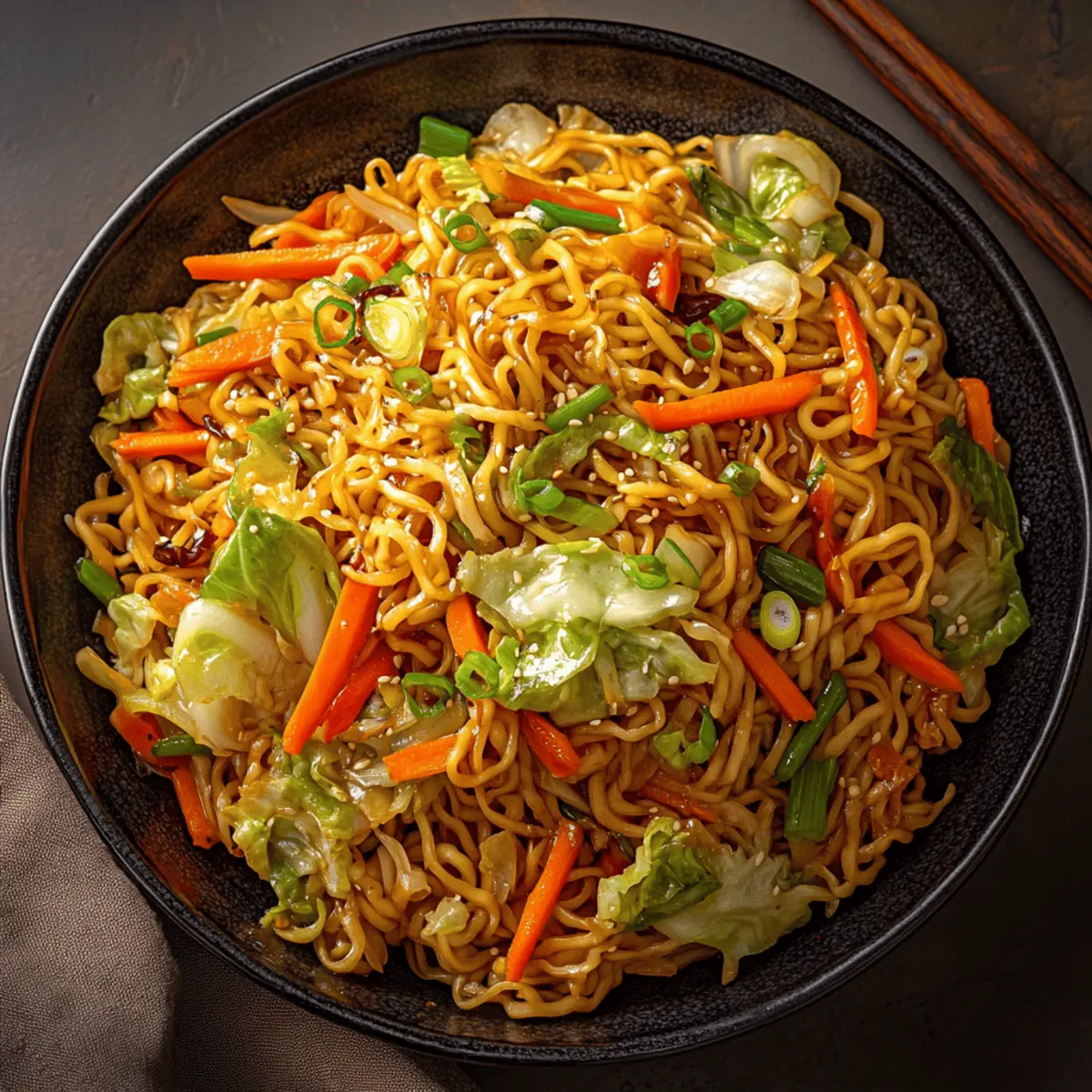
Japanese Yakisoba with Cabbage & Carrots Recipe FAQs
What kind of yakisoba noodles should I use?
For this recipe, you can opt for either fresh or instant-style yakisoba noodles. If using instant noodles, soak them in warm water for about 1–2 minutes to loosen them up before cooking. Fresh noodles are ready to go after a quick rinse under hot water.
How long can I store leftovers in the fridge?
Store any leftover Japanese Yakisoba in an airtight container in the refrigerator for up to 3 days. When reheating, do it gently over medium heat on the stovetop to avoid overcooking the noodles and maintaining the dish’s vibrant textures.
Can I freeze Japanese Yakisoba, and how?
Absolutely! To freeze your Japanese Yakisoba, portion it into freezer-safe containers or bags. It can last for about 2 months in the freezer. When you're ready to enjoy it again, simply thaw it overnight in the fridge. Reheat in a pan, adding a splash of water or broth to restore moisture as you stir-fry over medium heat.
What if my sauce turns out too watery?
If you find that your sauce is too watery, it's best to continue stir-frying over medium-high heat. This will allow excess moisture to evaporate and thicken the sauce. Keep tossing the noodles and vegetables for optimal flavor distribution. If you prefer a thicker sauce next time, you can also adjust the sugar or soy sauce amounts slightly.
Are there any dietary considerations for this recipe?
Yes, please note that the Worcestershire sauce typically contains anchovies, so it's not suitable for vegetarians. However, you can find vegetarian alternatives in stores, or create a sauce with soy sauce, rice vinegar, and brown sugar as a substitute. Always check ingredient labels for potential allergens if you're serving this dish to guests with dietary restrictions.
What's the best way to enjoy my leftover yakisoba?
The best way to enjoy your leftover Japanese Yakisoba is to simply reheat it gently on the stovetop. Adding a splash of water or vegetable broth during reheating will help revive the dish’s flavors and textures, preventing it from drying out. Enjoy those vibrant, savory bites all over again!
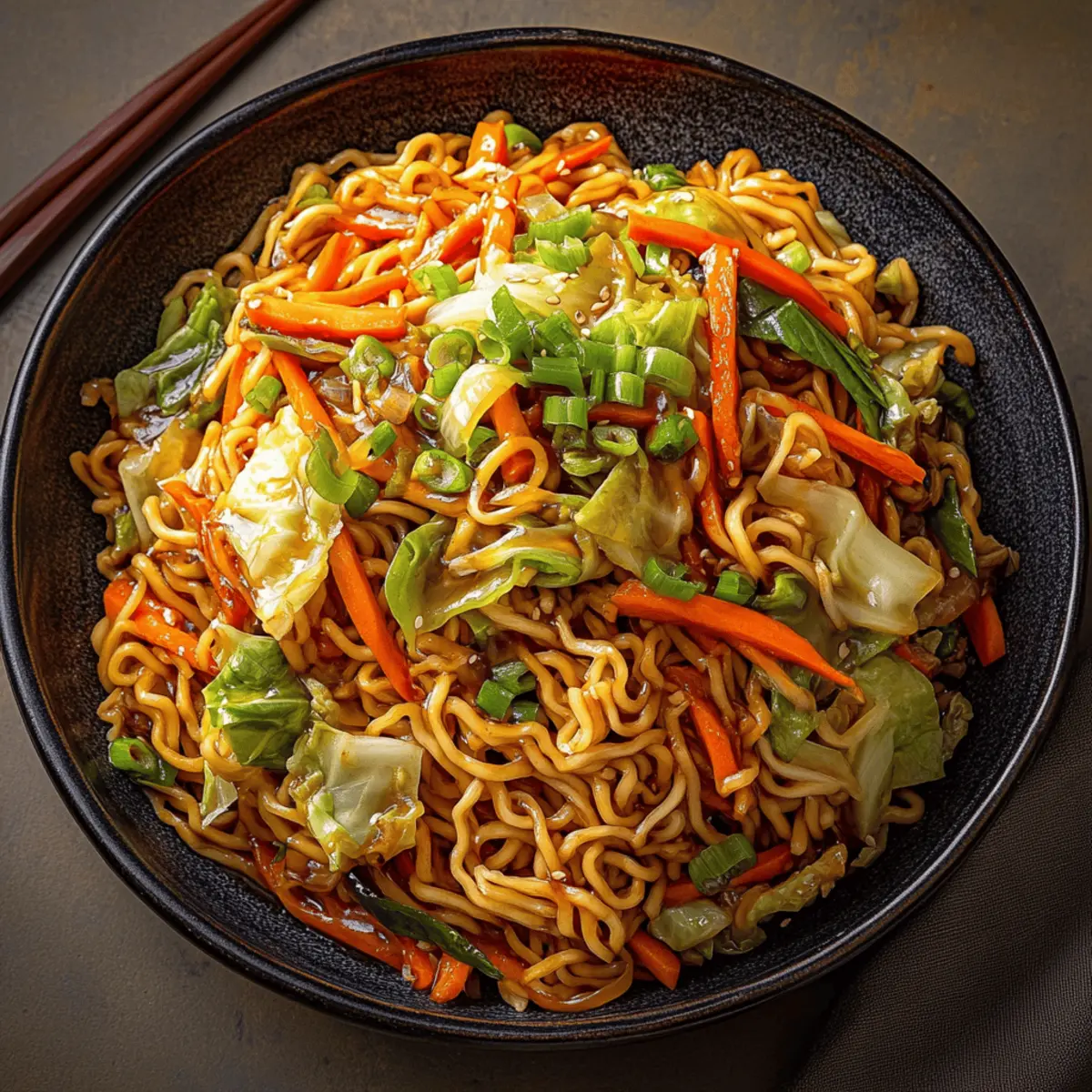
Savoring Japanese Yakisoba with Cabbage & Carrots Tonight
Ingredients
Equipment
Method
- In a bowl, whisk together the Worcestershire sauce, soy sauce, ketchup, oyster sauce, and sugar until well combined. Set the sauce aside.
- If using instant yakisoba noodles, soak them in warm water for 1–2 minutes until they loosen. Drain well.
- Place a large skillet or wok over medium-high heat and wait for faint smoke to rise.
- Add vegetable oil, followed by the sliced onions and julienned carrots. Stir-fry for 2–3 minutes until onions are translucent.
- Add shredded green cabbage and stir-fry for another 2–3 minutes until it wilts and is tender.
- Gently toss in the yakisoba noodles and pour the prepared sauce over the mixture. Stir-fry for 2–4 minutes.
- Stir in most of the sliced green onions, reserving some for garnish.
- Transfer the yakisoba to serving bowls and garnish with reserved green onions.

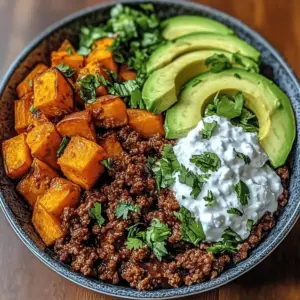


Leave a Reply